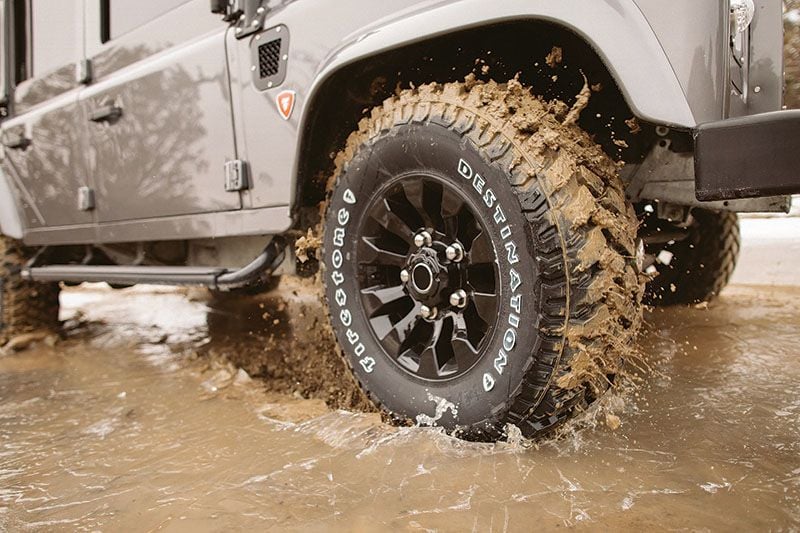For drivers who frequently venture off-road or face muddy, rugged terrain, having the right tires can make all the difference. Mud tires are specially designed to provide superior traction in challenging conditions, but they require proper care and understanding of tire safety to perform at their best. In this article, we’ll explore the benefits of mud tires, how to choose the right ones, and essential tire safety practices that ensure a safe, reliable driving experience.
What Are Mud Tires?
Mud tires are a type of off-road tire specifically engineered to tackle muddy, rocky, and uneven terrains. They’re crafted with deeper, more aggressive treads and larger voids to provide maximum grip, allowing your vehicle to navigate areas where standard road tires would struggle. The aggressive tread pattern helps to “bite” into loose surfaces, giving better traction and control.
Key Features of Mud Tires:
- Aggressive Tread Patterns: The large, deep grooves of mud tires help them grip slippery surfaces.
- Enhanced Sidewalls: Reinforced sidewalls offer extra strength and durability, making these tires resistant to punctures and cuts from sharp rocks or rough ground.
- Self-Cleaning Treads: Mud tires are designed to shed mud and debris, which helps maintain traction even as you drive through wet, sticky terrain.
Benefits of Mud Tires
Mud tires offer distinct advantages for off-road enthusiasts and drivers who often encounter rough, unpaved roads.
- Superior Traction on Loose Surfaces: The aggressive tread and larger tread blocks provide excellent grip on mud, gravel, and sand, allowing for safer and more controlled driving.
- Increased Durability: Made from tougher rubber compounds, mud tires are built to withstand the rough demands of off-roading. This durability translates into fewer punctures, cuts, and other potential issues on rocky trails.
- Enhanced Vehicle Stability: With better grip, mud tires improve vehicle stability, reducing the likelihood of getting stuck in soft, uneven surfaces.
- Versatile for Various Off-Road Conditions: Mud tires perform well in multiple terrains, including sand, loose dirt, and rocky trails, making them a great choice for adventurers who explore diverse landscapes.
Choosing the Right Mud Tires for Your Vehicle
With so many options on the market, finding the right mud tire can be challenging. Here are some factors to consider:
a) Tire Size
Selecting the correct tire size is crucial. Check your vehicle’s specifications to ensure the mud tires you choose fit perfectly without causing clearance issues. The right size will provide optimal performance and maintain vehicle safety.
b) Tread Depth and Pattern
Mud tires come in various tread patterns and depths, with each design tailored for specific terrains. Choose a tire with deeper, widely spaced lugs for heavily muddy conditions, as this design allows better self-cleaning and traction.
c) Load and Speed Ratings
Each tire has a load and speed rating that indicates its maximum carrying capacity and safe speed limit. Ensure the mud tires you choose align with your vehicle’s requirements, especially if you’ll be carrying heavy loads during off-road trips.
d) Sidewall Reinforcement
Look for tires with reinforced sidewalls if you plan on traversing rocky or harsh terrain. Stronger sidewalls will reduce the risk of punctures and improve overall tire durability.
e) Noise and Comfort on Pavement
Mud tires tend to be noisier on paved roads due to their aggressive tread design. If you plan to use them on-road as well, consider all-terrain tires with some off-road capability for a quieter, more comfortable ride.
4. Essential Tire Safety Tips
Tire safety is critical, regardless of where you drive. Proper maintenance and awareness of tire safety practices can improve your tires’ lifespan, ensure a smoother ride, and keep you safe on the road.
a) Regular Tire Inspections
Check your tires regularly for signs of wear, damage, or punctures. Look out for uneven wear patterns, cuts, or bulges, as these can compromise tire safety. For mud tires, make sure the tread is in good condition and hasn’t worn down excessively.
b) Proper Inflation
Maintaining the correct tire pressure is essential. Underinflated tires can lead to poor handling and increased wear, while overinflated tires reduce traction and may cause a rougher ride. Use a tire pressure gauge to ensure your tires are inflated to the recommended PSI (Pounds per Square Inch) specified by the manufacturer.
c) Tread Depth Checks
The depth of your tire tread is crucial, especially for mud tires. A worn tread compromises the tire’s grip, making it more difficult to navigate muddy and loose surfaces. Use a tread depth gauge to measure and ensure the tread is above the legal limit (typically 2/32 inches for standard tires, but deeper tread is ideal for mud tires).
d) Wheel Alignment
Misaligned wheels can lead to uneven tire wear, reducing the tire’s lifespan and compromising vehicle handling. Check and adjust your wheel alignment periodically, especially after driving on rough trails that may knock your alignment out of place.
e) Rotate Your Tires
Regular tire rotation helps to ensure even wear on all four tires, extending their life and maintaining balanced performance. Rotate your tires approximately every 5,000 to 8,000 miles, or as recommended by the manufacturer.
f) Avoid Overloading
Mud tires are designed for off-road use, but overloading your vehicle can cause unnecessary strain on the tires and increase the risk of a blowout. Always adhere to your vehicle’s load limit to prevent excessive stress on your tires.
5. How to Drive Safely on Mud Tires
While mud tires offer excellent traction, driving safely with them requires specific techniques, especially when transitioning from paved roads to off-road conditions.
a) Adjusting Speed and Steering
Due to the aggressive tread pattern, mud tires don’t offer the same level of control on paved roads as standard tires. Drive at moderate speeds on the highway, and make gentle steering adjustments to avoid instability.
b) Reducing Air Pressure for Off-Roading
When tackling rough terrain, slightly reducing air pressure can improve traction by allowing more surface contact with the ground. However, remember to reinflate your tires before returning to paved roads to prevent damage.
c) Avoiding Sharp Turns and Braking
On muddy and slippery surfaces, sharp turns or sudden braking can cause the vehicle to lose control. Instead, drive slowly and keep a steady pace, especially in deep mud or loose gravel.
d) Keep an Eye on Tire Temperature
Off-road conditions can heat up your tires quickly. If you’re driving on hot sand or rocky trails, check your tires periodically and give them time to cool down if necessary.
Recommended Mud Tires
Here are some popular mud tires known for their performance and durability:
- BFGoodrich Mud-Terrain T/A KM3: Known for its excellent grip and durability, the KM3 is perfect for both mud and rock crawling.
- Goodyear Wrangler MT/R with Kevlar: Reinforced with Kevlar, this tire offers improved sidewall protection, making it ideal for rough trails.
- Toyo Open Country M/T: With a reputation for longevity and traction, this tire performs well in various off-road conditions.
- Nitto Mud Grappler: This tire features a unique tread design that excels in mud, sand, and even snow.
- Cooper Discoverer STT Pro: Designed with aggressive traction in mind, the STT Pro offers exceptional handling on rugged terrain.
Balancing Off-Road Performance with On-Road Comfort
Mud tires are exceptional for off-road adventures but may be less suitable for daily on-road use. To balance off-road performance with on-road comfort, consider these options:
- Switch to All-Terrain Tires: If you only need moderate off-road capabilities, all-terrain tires offer a compromise between traction and comfort.
- Use a Dual Tire Setup: Some drivers use mud tires exclusively for off-road trips and swap them with standard tires for daily driving. While it involves extra effort, this setup extends the life of both tire types and enhances performance.
- Consider Lower Tread Mud Tires: Some mud tires are designed with a less aggressive tread for improved on-road comfort while still providing off-road traction.
Final Tips for Choosing and Maintaining Mud Tires
Mud tires are an investment in performance and safety for off-road enthusiasts. Follow these final tips to get the most out of your mud tires:
- Research Brands and Models: Choose reputable brands known for durability and quality. Look for user reviews to gain insights into real-world performance.
- Plan for Seasonal Storage: If you switch between mud tires and all-season tires, store your mud tires in a cool, dry place to prevent rubber deterioration.
- Replace Worn Tires: Even the best mud tires will wear down over time. Replace tires as soon as they show significant wear, as compromised tread can be dangerous on rugged terrain.
- Regularly Clean Your Tires: Mud tires can accumulate mud and debris, affecting performance. Clean your tires after each off-road trip to prevent damage and maintain traction.
Conclusion: Choosing and Using Mud Tires for Safe Off-Roading
Mud tires are essential for anyone who frequently tackles challenging terrains. With their aggressive tread design and rugged durability, they make off-road driving safer and more enjoyable. However, proper maintenance and adherence to tire safety practices are crucial for maximizing their performance and lifespan. By selecting the right mud tires, following safety guidelines, and performing regular maintenance, you can confidently drive through muddy, rocky, and rugged landscapes, knowing you have the best tools for the job.



